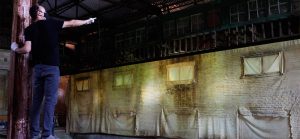Truth to Power
Hearing the roar of Niagara Falls for the first time since I was eight years old was chilling. Perhaps it was because I heard it not at the edge of the falls but in a cavernous 19th century ruin. It was at the abandoned pool house on the historic Lyndhurst estate. It was an empty pool, barren of water. Ironically, it was meant by the artist to provoke a conversation about water and the need to preserve it. I was invited there to witness an installation by artist and preservationist Jorge Otero Paillos. Water is in crisis in this country and around the world and Otero chose this remote and poignant location to have this conversation, at the edge of an abandoned waterless pool house. Artists have always spoken truth to power, and this juxtaposition of water and preservation is most compelling. I entered the pool house through an ante room that Pailos described as a stabilized ruin. It was then that I heard the unforgettable roar of Niagara Falls emanating from the massive but empty pool as if to echo the power of the water that was once there. We were surrounded by huge sheets of latex canvases that hung from the walls, imprinted with the detritus that was carefully lifted from the walls and preserved encausticly for what may be yet another century. Art can do that. It can take the remnants of a battered wall and use it to tell a story; or in this case send a warning about something we use and waste every day. Yes, go to the former home of railroad magnate Jay Gould and listen to the chips of paint and bits of dust. It’s what the past can tell us about the future.

“Watershed Moment” Installation at Lyndhurst


Connect with Janet